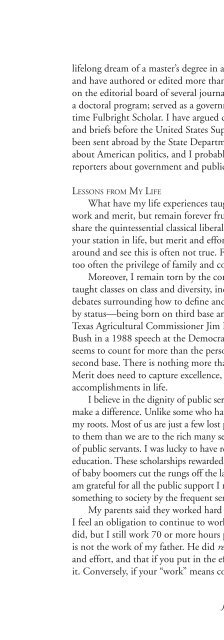WINTER 2012 - National Association of Schools of Public Affairs and ...
WINTER 2012 - National Association of Schools of Public Affairs and ...
WINTER 2012 - National Association of Schools of Public Affairs and ...
Create successful ePaper yourself
Turn your PDF publications into a flip-book with our unique Google optimized e-Paper software.
Bin Chen, Feng Wang <strong>and</strong> Jianmin Song<br />
(21.1%), academic network (10.2%), <strong>and</strong> socio-emotional network (0.31%).<br />
The results demonstrate that a few key actors are able to bridge the relationships<br />
among different subgroups in the career advice <strong>and</strong> friendship networks due to<br />
their central positions in the network.<br />
Reciprocity measures the extent to which network relationships are mutually<br />
directed. For example, if both A <strong>and</strong> B consider each other as friend, their<br />
friendship is reciprocal. When exchanges are reciprocated, network ties are<br />
more reliable <strong>and</strong> stable. Among the four networks, the friendship network<br />
tops the other three networks: 44% <strong>of</strong> friendship ties are reciprocal. The<br />
academic network descends to the second place (41.6%), career advice network<br />
ranks third (29.4%), <strong>and</strong> socio-emotional support network is last (20%). This<br />
finding suggests that the academic <strong>and</strong> friendship networks are more mutually<br />
beneficial than the career advice <strong>and</strong> socio-emotional support networks. It can<br />
be attributed to the fact that seeking career advice <strong>and</strong> information, <strong>and</strong> socioemotional<br />
support, by their nature, are usually unidirectional behaviors.<br />
Multiple Network Relationships<br />
It is possible for actors in social networks to have engaged in multiple<br />
types <strong>of</strong> relationships. For instance, after studying together for some time, two<br />
MPA students began to share job-related information <strong>and</strong> then became friends.<br />
From time to time, friends are <strong>of</strong>ten turned to for emotional help or social<br />
companionship. The presence <strong>of</strong> multiple exchange relationships is termed as<br />
multiplexity, referring to a structural property <strong>of</strong> a dyadic relationship that occurs<br />
when the two parties are involved in more than one relationship with each other<br />
(Wasserman & Faust, 1994; Boorman & White, 1976). Multiplex relationships<br />
are signs <strong>of</strong> strong relations <strong>and</strong> are associated with high trust <strong>and</strong> reliability since<br />
both parties have the opportunity to interact <strong>and</strong> get to know each other in a<br />
variety <strong>of</strong> contexts (Ibarra, 1995). We explored the extent to which the pattern <strong>of</strong><br />
interactions for one network aligns with that <strong>of</strong> interactions for another network<br />
among Chinese MPA students’ academic <strong>and</strong> social networks.<br />
In Figure 5, we graphically showed the multiplexity by combining the four<br />
networks into one diagram. Yet the complexity <strong>of</strong> the diagram makes it difficult<br />
to see the patterns <strong>of</strong> multiple exchange relationships. To further examine the<br />
extent to which multiplexity was present among the same cohort <strong>of</strong> MPA students,<br />
we applied quadratic assignment procedures (QAP) in UCINET to produce<br />
Pearson correlation coefficients. QAP also developed st<strong>and</strong>ard errors to test for<br />
the significance <strong>of</strong> association. Table 4 reports the result <strong>of</strong> our statistical analysis.<br />
150 Journal <strong>of</strong> <strong>Public</strong> <strong>Affairs</strong> Education

















